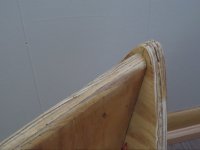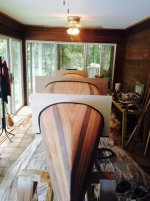- Joined
- Oct 20, 2015
- Messages
- 31
- Reaction score
- 0
Ok, this may be a strange question to all of you seasoned boat builders but it's got me perplexed. I am in the middle of building a strip boat. I've fiberglassed the exterior of the hull, removed the hull from its forms and glassed the interior. With the boat free of the support that its forms provided and turned upside down on saw horses I notice that the hull has a noticeable "hogback" that was not there when the boat was still on the forms and strong back. I have to assume that the bottom of the hull is sagging in due to the lack of support although I cant say for sure because I can't tell if the curve remains in place when the hull is turned right side up. I should add that no hog was present when the boat was on its forms and it had a perfectly straight string line until the the forms were removed. Question is --- is this common? What caused it? Should I fix it or what's the best way to remedy this issue if it's a problem? What would you guys do? Guess I should have mentioned, the boat is a 17 and a half foot solo with pretty extreme thumbhome, less than 30 inches wide, quarter inch cedar strips (although pretty heavily sanded) 6 oz E glass outside,
4 oz E glass inside.
Thanks John R
4 oz E glass inside.
Thanks John R



